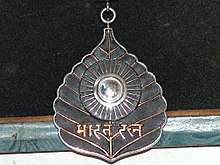B. R. Ambedkar
Bhimrao Ramji Ambedkar (14 April 1891 – 6 December 1956), also known as Babasaheb Ambedkar, was an Indian jurist, economist, politician and social reformer, who inspired the Dalit Buddhist movement and campaigned against social discrimination towards the untouchables (Dalits). He was independent India's first Minister of Law and Justice, and the chief architect of the Constitution of India.
Bhimrao Ramji Ambedkar | |
|---|---|
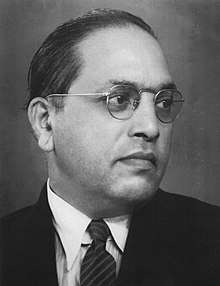 Ambedkar as a young man | |
| Member of Parliament of Rajya Sabha for Bombay State[1] | |
| In office 3 April 1952 – 6 December 1956 | |
| President | Rajendra Prasad |
| Prime Minister | Jawaharlal Nehru |
| 1st Minister of Law and Justice | |
| In office 15 August 1947 – 6 October 1951 | |
| President | Rajendra Prasad |
| Governor General | Louis Mountbatten C. Rajagopalachari |
| Prime Minister | Jawaharlal Nehru |
| Preceded by | Position established |
| Succeeded by | Charu Chandra Biswas |
| Chairman of the Constitution Drafting Committee | |
| In office 29 August 1947 – 24 January 1950 | |
| Member of the Constituent Assembly of India[2][3] | |
| In office 9 December 1946 – 24 January 1950 | |
| Constituency | • Bengal Province (1946-47) • Bombay Province (1947-50) |
| Minister of Labour in Viceroy's Executive Council [4][5] | |
| In office 22 July 1942 – 20 October 1946 | |
| Governor General | The Marquess of Linlithgow The Viscount Wavell |
| Preceded by | Feroz Khan Noon |
| Leader of the Opposition in the Bombay Legislative Assembly[6][7] | |
| In office 1937–1942 | |
| Member of the Bombay Legislative Assembly[8][9] | |
| In office 1937–1942 | |
| Constituency | Bombay City (Byculla and Parel) General Urban |
| Member of the Bombay Legislative Council[10][11][12] | |
| In office 1926–1937 | |
| Personal details | |
| Pronunciation | Bhīmrāo Rāmjī Āmbēḍkar |
| Born | Bhiva Ramji Sakpal 14 April 1891 Mhow, Central Provinces, British India (present-day Bhim Janmabhoomi, Dr. Ambedkar Nagar, Indore district, Madhya Pradesh, India) |
| Died | 6 December 1956 (aged 65) Dr. Ambedkar National Memorial[13][14] (Dr. Ambedkar Parinirvan Bhoomi), Delhi, New Delhi, India |
| Resting place | Chaitya Bhoomi, Mumbai 19.026149°N 72.834599°E |
| Nationality | Indian |
| Political party | • Independent Labour Party • Scheduled Castes Federation |
| Other political affiliations | • Republican Party of India |
| Spouse(s) | |
| Children | Yashwant Ambedkar |
| Mother | Bhimabai Ramji Sakpal |
| Father | Ramji Maloji Sakpal |
| Relatives | See Ambedkar family |
| Residence | • Rajgruha, Mumbai, Maharashtra • 26 Alipur road, Dr. Ambedkar National Memorial, New Delhi |
| Alma mater | |
| Profession |
|
| Known for | Dalit rights movement Drafting Constitution of India Dalit Buddhist movement |
| Awards | Bharat Ratna (posthumously in 1990) |
| Signature |  |
Ambedkar was a prolific student, earning doctorates in economics from both Columbia University and the London School of Economics, and gaining reputation as a scholar for his research in law, economics and political science.[15] In his early career, he was an economist, professor, and lawyer. His later life was marked by his political activities; he became involved in campaigning and negotiations for India's independence, publishing journals, advocating political rights and social freedom for Dalits, and contributing significantly to the establishment of the state of India. In 1956, he converted to Buddhism, initiating mass conversions of Dalits.[16]
In 1990, the Bharat Ratna, India's highest civilian award, was posthumously conferred upon Ambedkar. Ambedkar's legacy includes numerous memorials and depictions in popular culture.
Early life
Ambedkar was born on 14 April 1891 in the town and military cantonment of Mhow in the Central Provinces (now in Madhya Pradesh).[17] He was the 14th and last child of Ramji Maloji Sakpal, an army officer who held the rank of Subedar, and Bhimabai Sakpal, daughter of Laxman Murbadkar.[18] His family was of Marathi background from the town of Ambadawe (Mandangad taluka) in Ratnagiri district of modern-day Maharashtra. Ambedkar was born into a poor low Mahar (dalit) caste, who were treated as untouchables and subjected to socio-economic discrimination.[19] Ambedkar's ancestors had long worked for the army of the British East India Company, and his father served in the British Indian Army at the Mhow cantonment.[20] Although they attended school, Ambedkar and other untouchable children were segregated and given little attention or help by teachers. They were not allowed to sit inside the class. When they needed to drink water, someone from a higher caste had to pour that water from a height as they were not allowed to touch either the water or the vessel that contained it. This task was usually performed for the young Ambedkar by the school peon, and if the peon was not available then he had to go without water; he described the situation later in his writings as "No peon, No Water".[21] He was required to sit on a gunny sack which he had to take home with him.[22]
Ramji Sakpal retired in 1894 and the family moved to Satara two years later. Shortly after their move, Ambedkar's mother died. The children were cared for by their paternal aunt and lived in difficult circumstances. Three sons – Balaram, Anandrao and Bhimrao – and two daughters – Manjula and Tulasa – of the Ambedkars survived them. Of his brothers and sisters, only Ambedkar passed his examinations and went to high school. His original surname was Sakpal but his father registered his name as Ambadawekar in school, meaning he comes from his native village 'Ambadawe' in Ratnagiri district.[23][23][24][25][26] His Devrukhe Brahmin teacher, Krishnaji Keshav Ambedkar, changed his surname from 'Ambadawekar' to his own surname 'Ambedkar' in school records.[27][28][29][30][31]
Education
Post-secondary education
In 1897, Ambedkar's family moved to Mumbai where Ambedkar became the only untouchable enrolled at Elphinstone High School. In 1906, when he was about 15 years old, his marriage to a nine-year-old girl, Ramabai, was arranged.[32]
Undergraduate studies at the University of Bombay
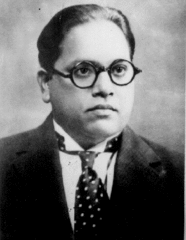
In 1907, he passed his matriculation examination and in the following year he entered Elphinstone College, which was affiliated to the University of Bombay, becoming, according to him, the first from his Mahar caste to do so. When he passed his English fourth standard examinations, the people of his community wanted to celebrate because they considered that he had reached "great heights" which he says was "hardly an occasion compared to the state of education in other communities". A public ceremony was evoked, to celebrate his success, by the community, and it was at this occasion that he was presented with a biography of the Buddha by Dada Keluskar, the author and a family friend.[33]
By 1912, he obtained his degree in economics and political science from Bombay University, and prepared to take up employment with the Baroda state government. His wife had just moved his young family and started work when he had to quickly return to Mumbai to see his ailing father, who died on 2 February 1913.[34]
Postgraduate studies at Columbia University
In 1913, Ambedkar moved to the United States at the age of 22. He had been awarded a Baroda State Scholarship of £11.50 (Sterling) per month for three years under a scheme established by Sayajirao Gaekwad III (Gaekwad of Baroda) that was designed to provide opportunities for postgraduate education at Columbia University in New York City. Soon after arriving there he settled in rooms at Livingston Hall with Naval Bhathena, a Parsi who was to be a lifelong friend. He passed his M.A. exam in June 1915, majoring in Economics, and other subjects of Sociology, History, Philosophy and Anthropology. He presented a thesis, Ancient Indian Commerce. Ambedkar was influenced by John Dewey and his work on democracy.[35]
In 1916 he completed his second thesis, National Dividend of India - A Historic and Analytical Study, for another M.A.[36] On 9 May, he presented the paper Castes in India: Their Mechanism, Genesis and Development before a seminar conducted by the anthropologist Alexander Goldenweiser.
Postgraduate studies at the London School of Economics
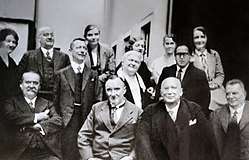
In October 1916, he enrolled for the Bar course at Gray's Inn, and at the same time enrolled at the London School of Economics where he started working on a doctoral thesis. In June 1917, he returned to India because his scholarship from Baroda ended. His book collection was dispatched on different ship from the one he was on, and that ship was torpedoed and sunk by a German submarine.[34] He got permission to return to London to submit his thesis within four years. He returned at the first opportunity, and completed a master's degree in 1921. His thesis was on "The problem of the rupee: Its origin and its solution".[37] In 1923, he completed a D.Sc. in Economics, and the same year he was called to the Bar by Gray's Inn. His third and fourth Doctorates (LL.D, Columbia, 1952 and D.Litt., Osmania, 1953) were conferred honoris causa.[38]
Opposition to Aryan invasion theory
Ambedkar viewed the Shudras as Aryan and adamantly rejected the Aryan invasion theory, describing it as "so absurd that it ought to have been dead long ago" in his 1946 book Who Were the Shudras?.[39]
Ambedkar viewed Shudras as originally being "part of the Kshatriya Varna in the Indo-Aryan society", but became socially degraded after they inflicted many tyrannies on Brahmins.[40]
According to Arvind Sharma, Ambedkar noticed certain flaws in the Aryan invasion theory that were later acknowledged by western scholarship. For example, scholars now acknowledge anās in Rig Veda 5.29.10 refers to speech rather than the shape of the nose.[41] Ambedkar anticipated this modern view by stating:
The term Anasa occurs in Rig Veda V.29.10. What does the word mean? There are two interpretations. One is by Prof. Max Muller. The other is by Sayanacharya. According to Prof. Max Muller, it means 'one without nose' or 'one with a flat nose' and has as such been relied upon as a piece of evidence in support of the view that the Aryans were a separate race from the Dasyus. Sayanacharya says that it means 'mouthless,' i.e., devoid of good speech. This difference of meaning is due to difference in the correct reading of the word Anasa. Sayanacharya reads it as an-asa while Prof. Max Muller reads it as a-nasa. As read by Prof. Max Muller, it means 'without nose.' Question is : which of the two readings is the correct one? There is no reason to hold that Sayana's reading is wrong. On the other hand there is everything to suggest that it is right. In the first place, it does not make non-sense of the word. Secondly, as there is no other place where the Dasyus are described as noseless, there is no reason why the word should be read in such a manner as to give it an altogether new sense. It is only fair to read it as a synonym of Mridhravak. There is therefore no evidence in support of the conclusion that the Dasyus belonged to a different race.[41]
Ambedkar disputed various hypotheses of the Aryan homeland being outside India, and concluded the Aryan homeland was India itself.[42] According to Ambedkar, the Rig Veda says Aryans, Dāsa and Dasyus were competing religious groups, not different peoples.[43]
Opposition to untouchability

As Ambedkar was educated by the Princely State of Baroda, he was bound to serve it. He was appointed Military Secretary to the Gaikwad but had to quit in a short time. He described the incident in his autobiography, Waiting for a Visa.[44] Thereafter, he tried to find ways to make a living for his growing family. He worked as a private tutor, as an accountant, and established an investment consulting business, but it failed when his clients learned that he was an untouchable.[45] In 1918, he became Professor of Political Economy in the Sydenham College of Commerce and Economics in Mumbai. Although he was successful with the students, other professors objected to his sharing a drinking-water jug with them.[46]
Ambedkar had been invited to testify before the Southborough Committee, which was preparing the Government of India Act 1919. At this hearing, Ambedkar argued for creating separate electorates and reservations for untouchables and other religious communities.[47] In 1920, he began the publication of the weekly Mooknayak (Leader of the Silent) in Mumbai with the help of Shahu of Kolhapur i.e. Shahu IV (1874–1922).[48]
Ambedkar went on to work as a legal professional. In 1926, he successfully defended three non-Brahmin leaders who had accused the Brahmin community of ruining India and were then subsequently sued for libel. Dhananjay Keer notes that "The victory was resounding, both socially and individually, for the clients and the doctor".
While practising law in the Bombay High Court, he tried to promote education to untouchables and uplift them. His first organised attempt was his establishment of the central institution Bahishkrit Hitakarini Sabha, intended to promote education and socio-economic improvement, as well as the welfare of "outcastes", at the time referred to as depressed classes.[49] For the defence of Dalit rights, he started many periodicals like Mook Nayak, Bahishkrit Bharat, and Equality Janta.[50]
He was appointed to the Bombay Presidency Committee to work with the all-European Simon Commission in 1925.[51] This commission had sparked great protests across India, and while its report was ignored by most Indians, Ambedkar himself wrote a separate set of recommendations for the future Constitution of India.[52]
By 1927, Ambedkar had decided to launch active movements against untouchability. He began with public movements and marches to open up public drinking water resources. He also began a struggle for the right to enter Hindu temples. He led a satyagraha in Mahad to fight for the right of the untouchable community to draw water from the main water tank of the town.[53] In a conference in late 1927, Ambedkar publicly condemned the classic Hindu text, the Manusmriti (Laws of Manu), for ideologically justifying caste discrimination and "untouchability", and he ceremonially burned copies of the ancient text. On 25 December 1927, he led thousands of followers to burn copies of Manusmrti.[54][55] Thus annually 25 December is celebrated as Manusmriti Dahan Din (Manusmriti Burning Day) by Ambedkarites and Dalits.[56][57]
In 1930, Ambedkar launched Kalaram Temple movement after three months of preparation. About 15,000 volunteers assembled at Kalaram Temple satygraha making one of the greatest processions of Nashik. The procession was headed by a military band, a batch of scouts, women and men walked in discipline, order and determination to see the god for the first time. When they reached to gate, the gates were closed by Brahmin authorities.[58]
Poona Pact
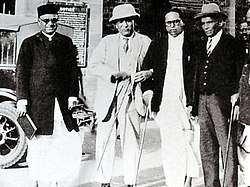
In 1932, British announced the formation of a separate electorate for "Depressed Classes" in the Communal Award. Gandhi fiercely opposed a separate electorate for untouchables, saying he feared that such an arrangement would divide the Hindu community.[59][60][61] Gandhi protested by fasting while imprisoned in the Yerwada Central Jail of Poona. Following the fast, Congress politicians and activists such as Madan Mohan Malaviya and Palwankar Baloo organised joint meetings with Ambedkar and his supporters at Yerwada.[62] On 25 September 1932, the agreement known as Poona Pact was signed between Ambedkar (on behalf of the depressed classes among Hindus) and Madan Mohan Malaviya (on behalf of the other Hindus). The agreement gave reserved seats for the depressed classes in the Provisional legislatures, within the general electorate. Due to the pact, the depressed class received 148 seats in the legislature, instead of the 71 as allocated in the Communal Award earlier proposed by British Prime Minister Ramsay MacDonald. The text uses the term "Depressed Classes" to denote Untouchables among Hindus who were later called Scheduled Castes and Scheduled Tribes under India Act 1935, and the later Indian Constitution of 1950.[63][64] In the Poona Pact, a unified electorate was in principle formed, but primary and secondary elections allowed Untouchables in practice to choose their own candidates.[65]
Political career
_Yashwant%2C_BR_Ambedkar%2C_Ramabai%2C_Laxmibai%2C_Mukundrao%2C_and_Tobby.jpg)
In 1935, Ambedkar was appointed principal of the Government Law College, Bombay, a position he held for two years. He also served as the chairman of Governing body of Ramjas College, University of Delhi, after the death of its Founder Shri Rai Kedarnath.[66] Settling in Bombay (today called Mumbai), Ambedkar oversaw the construction of a house, and stocked his personal library with more than 50,000 books.[67] His wife Ramabai died after a long illness the same year. It had been her long-standing wish to go on a pilgrimage to Pandharpur, but Ambedkar had refused to let her go, telling her that he would create a new Pandharpur for her instead of Hinduism's Pandharpur which treated them as untouchables. At the Yeola Conversion Conference on 13 October in Nasik, Ambedkar announced his intention to convert to a different religion and exhorted his followers to leave Hinduism.[67] He would repeat his message at many public meetings across India.
In 1936, Ambedkar founded the Independent Labour Party, which contested the 1937 Bombay election to the Central Legislative Assembly for the 13 reserved and 4 general seats, and secured 11 and 3 seats respectively.[68]
Ambedkar published his book Annihilation of Caste on 15 May 1936.[69] It strongly criticised Hindu orthodox religious leaders and the caste system in general,[70] and included "a rebuke of Gandhi" on the subject.[71] Later, in a 1955 BBC interview, he accused Gandhi of writing in opposition of the caste system in English language papers while writing in support of it in Gujarati language papers.[72]
Ambedkar served on the Defence Advisory Committee[5] and the Viceroy's Executive Council as minister for labour.[5]
After the Lahore resolution (1940) of the Muslim League demanding Pakistan, Ambedkar wrote a 400 page tract titled Thoughts on Pakistan, which analysed the concept of "Pakistan" in all its aspects. Ambedkar argued that the Hindus should concede Pakistan to the Muslims. He proposed that the provincial boundaries of Punjab and Bengal should be redrawn to separate the Muslim and non-Muslim majority parts. He thought the Muslims could have no objection to redrawing provincial boundaries. If they did, they did not quite "understand the nature of their own demand". Scholar Venkat Dhulipala states that Thoughts on Pakistan "rocked Indian politics for a decade". It determined the course of dialogue between the Muslim League and the Indian Naitonal Congress, paving the way for the Partition of India.[73][74]
In his work Who Were the Shudras?, Ambedkar tried to explain the formation of untouchables. He saw Shudras and Ati Shudras who form the lowest caste in the ritual hierarchy of the caste system, as separate from Untouchables. Ambedkar oversaw the transformation of his political party into the Scheduled Castes Federation, although it performed poorly in the 1946 elections for Constituent Assembly of India. Later he was elected into the constituent assembly of Bengal where Muslim League was in power.[2]
Ambedkar contested in the Bombay North first Indian General Election of 1952, but lost to his former assistant and Congress Party candidate Narayan Kajrolkar. Ambedkar became a member of Rajya Sabha, probably an appointed member. He tried to enter Lok Sabha again in the by-election of 1954 from Bhandara, but he placed third (the Congress Party won). By the time of the second general election in 1957, Ambedkar had died.
Ambedkar also criticised Islamic practice in South Asia. While justifying the Partition of India, he condemned child marriage and the mistreatment of women in Muslim society.
No words can adequately express the great and many evils of polygamy and concubinage, and especially as a source of misery to a Muslim woman. Take the caste system. Everybody infers that Islam must be free from slavery and caste. [...] [While slavery existed], much of its support was derived from Islam and Islamic countries. While the prescriptions by the Prophet regarding the just and humane treatment of slaves contained in the Koran are praiseworthy, there is nothing whatever in Islam that lends support to the abolition of this curse. But if slavery has gone, caste among Musalmans [Muslims] has remained.[75]
Drafting India's Constitution

Upon India's independence on 15 August 1947, the new Congress-led government invited Ambedkar to serve as the nation's first Law Minister, which he accepted. On 29 August, he was appointed Chairman of the Constitution Drafting Committee, and was appointed by the Assembly to write India's new Constitution.[76]
Granville Austin described the Indian Constitution drafted by Ambedkar as 'first and foremost a social document'. 'The majority of India's constitutional provisions are either directly arrived at furthering the aim of social revolution or attempt to foster this revolution by establishing conditions necessary for its achievement.'[77]
The text prepared by Ambedkar provided constitutional guarantees and protections for a wide range of civil liberties for individual citizens, including freedom of religion, the abolition of untouchability, and the outlawing of all forms of discrimination. Ambedkar argued for extensive economic and social rights for women, and won the Assembly's support for introducing a system of reservations of jobs in the civil services, schools and colleges for members of scheduled castes and scheduled tribes and Other Backward Class, a system akin to affirmative action. India's lawmakers hoped to eradicate the socio-economic inequalities and lack of opportunities for India's depressed classes through these measures.[78] The Constitution was adopted on 26 November 1949 by the Constituent Assembly.[79]
Opposition to Article 370
Ambedkar opposed Article 370 of the Constitution of India, which granted a special status to the State of Jammu and Kashmir, and which was included against his wishes. Balraj Madhok reportedly said, Ambedkar had clearly told the Kashmiri leader, Sheikh Abdullah: "You wish India should protect your borders, she should build roads in your area, she should supply you food grains, and Kashmir should get equal status as India. But Government of India should have only limited powers and Indian people should have no rights in Kashmir. To give consent to this proposal, would be a treacherous thing against the interests of India and I, as the Law Minister of India, will never do it." Then Sk. Abdullah approached Nehru, who directed him to Gopal Swami Ayyangar, who in turn approached Sardar Patel, saying Nehru had promised Sk. Abdullah the special status. Patel got the Article passed while Nehru was on a foreign tour. On the day the article came up for discussion, Ambedkar did not reply to questions on it but did participate on other articles. All arguments were done by Krishna Swami Ayyangar.[80][81]
Support to Uniform Civil Code
During the debates in the Constituent Assembly, Ambedkar demonstrated his will to reform Indian society by recommending the adoption of a Uniform Civil Code.[83][84] Ambedkar resigned from the cabinet in 1951, when parliament stalled his draft of the Hindu Code Bill, which sought to enshrine gender equality in the laws of inheritance and marriage.[85] Ambedkar independently contested an election in 1952 to the lower house of parliament, the Lok Sabha, but was defeated in the Bombay (North Central) constituency by a little-known Narayan Sadoba Kajrolkar, who polled 138,137 votes compared to Ambedkar's 123,576.[86][87][88] He was appointed to the upper house, of parliament, the Rajya Sabha in March 1952 and would remain as member till death.[89]
Economic planning
Ambedkar was the first Indian to pursue a doctorate in economics abroad.[90] He argued that industrialisation and agricultural growth could enhance the Indian economy.[91] He stressed investment in agriculture as the primary industry of India. According to Sharad Pawar, Ambedkar’s vision helped the government to achieve its food security goal.[92] Ambedkar advocated national economic and social development, stressing education, public hygiene, community health, residential facilities as the basic amenities.[91] His DSc thesis "The problem of the Rupee: Its origin and solution" (1923) examines the causes for the Rupee's fall in value. He proved the importance of price stability over exchange stability. He analysed the silver and gold exchange rates and their effect on the economy, and found the reasons for the failure of British India's public treasury. He calculated the loss of development caused by British rule.[93]
In 1951, Ambedkar established the Finance Commission of India. He opposed income tax for low-income groups. He contributed in Land Revenue Tax and excise duty policies to stabilise the economy. He played an important role in land reform and the state economic development.[94] According to him, the caste system divided labourors and impeded economic progress. He emphasised a free economy with a stable Rupee which India has adopted recently. He advocated birth control to develop the Indian economy, and this has been adopted by Indian government as national policy for family planning. He emphasised equal rights for women for economic development. He laid the foundation of industrial relations after Indian independence.[94]
Reserve Bank of India
Ambedkar was trained as an economist, and was a professional economist until 1921, when he became a political leader. He wrote three scholarly books on economics:
- Administration and Finance of the East India Company
- The Evolution of Provincial Finance in British India
- The Problem of the Rupee: Its Origin and Its Solution[95][96][97]
The Reserve Bank of India (RBI), was based on the ideas that Ambedkar presented to the Hilton Young Commission.[95][97][98][99]
Second marriage
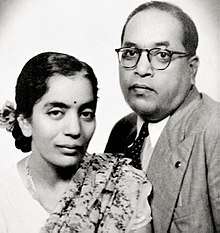
Ambedkar's first wife Ramabai died in 1935 after a long illness. After completing the draft of India's constitution in the late 1940s, he suffered from lack of sleep, had neuropathic pain in his legs, and was taking insulin and homoeopathic medicines. He went to Bombay for treatment, and there met Dr. Sharada Kabir, whom he married on 15 April 1948, at his home in New Delhi. Doctors recommended a companion who was a good cook and had medical knowledge to care for him.[100] She adopted the name Savita Ambedkar and cared for him the rest of his life.[101] Savita Ambedkar, who was called 'Mai', died on May 29, 2003, aged 93 at Mehrauli, New Delhi.[102]
Conversion to Buddhism
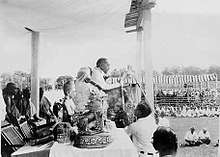
Ambedkar considered converting to Sikhism, which encouraged opposition to oppression and so appealed to leaders of scheduled castes. But after meeting with Sikh leaders, he concluded that he might get "second-rate" Sikh status.[103]
Instead, around 1950, he began devoting his attention to Buddhism and travelled to Ceylon (now Sri Lanka) to attend a meeting of the World Fellowship of Buddhists.[104] While dedicating a new Buddhist vihara near Pune, Ambedkar announced he was writing a book on Buddhism, and that when it was finished, he would formally convert to Buddhism.[105] He twice visited Burma in 1954; the second time to attend the third conference of the World Fellowship of Buddhists in Rangoon.[106] In 1955, he founded the Bharatiya Bauddha Mahasabha, or the Buddhist Society of India.[107] He completed his final work, The Buddha and His Dhamma, in 1956 which was published posthumously.[107]
After meetings with the Sri Lankan Buddhist monk Hammalawa Saddhatissa,[108] Ambedkar organised a formal public ceremony for himself and his supporters in Nagpur on 14 October 1956. Accepting the Three Refuges and Five Precepts from a Buddhist monk in the traditional manner, Ambedkar completed his own conversion, along with his wife. He then proceeded to convert some 500,000 of his supporters who were gathered around him.[105][109] He prescribed the 22 Vows for these converts, after the Three Jewels and Five Precepts. He then travelled to Kathmandu, Nepal to attend the Fourth World Buddhist Conference.[106] His work on The Buddha or Karl Marx and "Revolution and counter-revolution in ancient India" remained incomplete.
Death
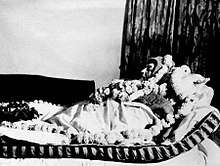
Since 1948, Ambedkar suffered from diabetes. He was bed-ridden from June to October in 1954 due to medication side-effects and poor eyesight.[105] His health worsened during 1955. Three days after completing his final manuscript The Buddha and His Dhamma, Ambedkar died in his sleep on 6 December 1956 at his home in Delhi.
A Buddhist cremation was organised at Dadar Chowpatty beach on 7 December,[110] attended by half a million grieving people.[111] A conversion program was organised on 16 December 1956,[112] so that cremation attendees were also converted to Buddhism at the same place.[112]
Ambedkar was survived by his second wife Savita Ambedkar (known as Maisaheb Ambedkar), who died in 2003,[113] and his son Yashwant Ambedkar (known as Bhaiyasaheb Ambedkar), who died in 1977.[114] Savita and Yashwant carried on the socio-religious movement started by B. R. Ambedkar. Yashwant served as the 2nd President of the Buddhist Society of India (1957–1977) and a member of the Maharashtra Legislative Council (1960–1966).[115][116] Ambedkar's elder grandson, Prakash Yashwant Ambedkar, is the chief-adviser of the Buddhist Society of India,[117] leads the Vanchit Bahujan Aghadi[118][119] and has served in both houses of the Indian Parliament.[119] Ambedkar's younger grandson, Anandraj Ambedkar leads the Republican Sena (tran: The "Republican Army").[120]
A number of unfinished typescripts and handwritten drafts were found among Ambedkar's notes and papers and gradually made available. Among these were Waiting for a Visa, which probably dates from 1935–36 and is an autobiographical work, and the Untouchables, or the Children of India's Ghetto, which refers to the census of 1951.[105]
A memorial for Ambedkar was established in his Delhi house at 26 Alipur Road. His birthdate is celebrated as a public holiday known as Ambedkar Jayanti or Bhim Jayanti. He was posthumously awarded India's highest civilian honour, the Bharat Ratna, in 1990.[121]
On the anniversary of his birth and death, and on Dhamma Chakra Pravartan Din (14 October) at Nagpur, at least half a million people gather to pay homage to him at his memorial in Mumbai.[122] Thousands of bookshops are set up, and books are sold. His message to his followers was "educate, agitate, organise!".[123]
Legacy
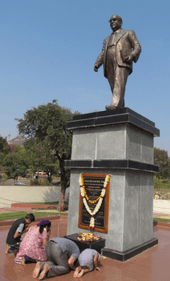
Ambedkar's legacy as a socio-political reformer, had a deep effect on modern India.[124][125] In post-Independence India, his socio-political thought is respected across the political spectrum. His initiatives have influenced various spheres of life and transformed the way India today looks at socio-economic policies, education and affirmative action through socio-economic and legal incentives. His reputation as a scholar led to his appointment as free India's first law minister, and chairman of the committee for drafting the constitution. He passionately believed in individual freedom and criticised caste society. His accusations of Hinduism as being the foundation of the caste system made him controversial and unpopular among Hindus.[126] His conversion to Buddhism sparked a revival in interest in Buddhist philosophy in India and abroad.[127]
Many public institutions are named in his honour, and the Dr. Babasaheb Ambedkar International Airport in Nagpur, otherwise known as Sonegaon Airport. Dr. B. R. Ambedkar National Institute of Technology, Jalandhar, Ambedkar University Delhi is also named in his honour.
The Maharashtra government has acquired a house in London where Ambedkar lived during his days as a student in the 1920s. The house is expected to be converted into a museum-cum-memorial to Ambedkar.[128]
Ambedkar was voted "the Greatest Indian" in 2012 by a poll organised by History TV18 and CNN IBN, ahead of Patel and Nehru.[129] Nearly 20 million votes were cast.[130] Due to his role in economics, Narendra Jadhav, a notable Indian economist,[131] has said that Ambedkar was "the highest educated Indian economist of all times."[132] Amartya Sen, said that Ambedkar is "father of my economics", and "he was highly controversial figure in his home country, though it was not the reality. His contribution in the field of economics is marvelous and will be remembered forever."[133][134]
.jpg)
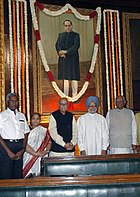
(right) The portrait of B. R. Ambedkar in the Central Hall of the Parliament House
On 2 April 1967, an 3.66 metre (12 foot) tall bronze statue of Ambedkar was installed in the Parliament of India. The statue, sculpted by B.V. Wagh, was unveiled by the then President of India, Sarvepalli Radhakrishnan.[135][136][137] On 12 April 1990, a portrait of Dr. B.R. Ambedkar is put in the Central Hall of Parliament House.[138][139][140] The portrait of Ambedkar, painted by Zeba Amrohawi, was unveiled by the then Prime Minister of India, V. P. Singh.[141] Another portrait of Ambedkar is put in the Parliamentary Museum and archives of the Parliament House.[142][143]
Indian Post issued stamps dedicated to his birthday in 1966, 1973, 1991, 2001, and 2013, and featured him on other stamps in 2009, 2015, 2016 and 2017.[144][145]
Ambedkar's legacy was not without criticism. Ambedkar has been criticised for his one-sided views on the issue of caste at the expense of cooperation with the larger nationalist movement.[146] Ambedkar has been also criticised by some of his biographers over his neglect of organization-building.[147]
Ambedkar's political philosophy has given rise to a large number of political parties, publications and workers' unions that remain active across India, especially in Maharashtra. His promotion of Buddhism has rejuvenated interest in Buddhist philosophy among sections of population in India. Mass conversion ceremonies have been organised by human rights activists in modern times, emulating Ambedkar's Nagpur ceremony of 1956.[148] Some Indian Buddhists regard him as a Bodhisattva, although he never claimed it himself.[149] Outside India, during the late 1990s, some Hungarian Romani people drew parallels between their own situation and that of the downtrodden people in India. Inspired by Ambedkar, they started to convert to Buddhism.[150]
In popular culture
Several movies, plays, and other works have been based on the life and thoughts of Ambedkar. Jabbar Patel directed the English-language film Dr. Babasaheb Ambedkar in 2000 with Mammootty in the lead role.[151] This biopic was sponsored by the National Film Development Corporation of India and the government's Ministry of Social Justice and Empowerment. The film was released after a long and controversial gestation.[152] David Blundell, professor of anthropology at UCLA and historical ethnographer, has established Arising Light – a series of films and events that are intended to stimulate interest and knowledge about the social conditions in India and the life of Ambedkar.[153] In Samvidhaan,[154] a TV mini-series on the making of the Constitution of India directed by Shyam Benegal, the pivotal role of B. R. Ambedkar was played by Sachin Khedekar. The play Ambedkar Aur Gandhi, directed by Arvind Gaur and written by Rajesh Kumar, tracks the two prominent personalities of its title.[155]
Bhimayana: Experiences of Untouchability is a graphic biography of Ambedkar created by Pardhan-Gond artists Durgabai Vyam and Subhash Vyam, and writers Srividya Natarajan and S. Anand. The book depicts the experiences of untouchability faced by Ambedkar from childhood to adulthood. CNN named it one of the top 5 political comic books.[156]
The Ambedkar Memorial at Lucknow is dedicated in his memory. The chaitya consists of monuments showing his biography.[157][158]
Jai Bhim slogan was given by the dalit community in Delhi in his honour on 1946.
Google commemorated Ambedkar's 124th birthday through a homepage doodle[159] on 14 April 2015.[160] The doodle was featured in India, Argentina, Chile, Ireland, Peru, Poland, Sweden and the United Kingdom.[161][162][163]
A television show named Ek Mahanayak: Dr. B. R. Ambedkar portraying his life aired on &TV in 2019.[164]
Works
The Education Department, Government of Maharashtra (Mumbai) published the collection of Ambedkar's writings and speeches in different volumes.[165]
- Castes in India: Their Mechanism, Genesis and Development and 11 Other Essays
- Ambedkar in the Bombay Legislature, with the Simon Commission and at the Round Table Conferences, 1927–1939
- Philosophy of Hinduism; India and the Pre-requisites of Communism; Revolution and Counter-revolution; Buddha or Karl Marx
- Riddles in Hinduism
- Essays on Untouchables and Untouchability
- The Evolution of Provincial Finance in British India
- The Untouchables Who Were They And Why They Became Untouchables ?
- The Annihilation of Caste (1936)
- Pakistan or the Partition of India
- What Congress and Gandhi have done to the Untouchables; Mr. Gandhi and the Emancipation of the Untouchables
- Ambedkar as member of the Governor General's Executive Council, 1942–46
- The Buddha and his Dhamma
- Unpublished Writings; Ancient Indian Commerce; Notes on laws; Waiting for a Visa ; Miscellaneous notes, etc.
- Ambedkar as the principal architect of the Constitution of India
- (2 parts) Dr. Ambedkar and The Hindu Code Bill
- Ambedkar as Free India's First Law Minister and Member of Opposition in Indian Parliament (1947–1956)
- The Pali Grammar
- Ambedkar and his Egalitarian Revolution – Struggle for Human Rights. Events starting from March 1927 to 17 November 1956 in the chronological order; Ambedkar and his Egalitarian Revolution – Socio-political and religious activities. Events starting from November 1929 to 8 May 1956 in the chronological order; Ambedkar and his Egalitarian Revolution – Speeches. (Events starting from 1 January to 20 November 1956 in the chronological order.)
References
- Sabha, Rajya. "Alphabetical List of All Members of Rajya Sabha Since 1952". Rajya Sabha Secretariat. Archived from the original on 9 January 2010.
Serial Number 69 in the list
- "Attention BJP: When the Muslim League rescued Ambedkar from the 'dustbin of history'". Firstpost. 15 April 2015. Archived from the original on 20 September 2015. Retrieved 5 September 2015.
- https://rajyasabhahindi.nic.in/rshindi/constituent_assembly/constituent_assembly_main.asp
- Keer, Dhananjay (13 August 1971). "Dr. Ambedkar: Life and Mission". Popular Prakashan – via Google Books.
- Jaffrelot, Christophe (2005). Dr Ambedkar and Untouchability: Analysing and Fighting Caste. London: C. Hurst & Co. Publishers. p. 5. ISBN 1850654492.
- Khairmode, Changdev Bhawanrao (1985). Dr. Bhimrao Ramji Ambedkar (Vol. 7) (in Marathi). Mumbai: Maharashtra Rajya Sahilya Sanskruti Mandal, Matralaya. p. 245.
- Jaffrelot, Christophe (2005). Dr Ambedkar and Untouchability: Analysing and Fighting Caste. London: C. Hurst & Co. Publishers. pp. 76–77. ISBN 978-1850654490.
- Khairmode, Changdev Bhawanrao (1985). Dr. Bhimrao Ramji Ambedkar (Vol. 7) (in Marathi). Mumbai: Maharashtra Rajya Sahilya Sanskruti Mandal, Matralaya. p. 245.
- Jaffrelot, Christophe (2005). Dr Ambedkar and Untouchability: Analysing and Fighting Caste. London: C. Hurst & Co. Publishers. pp. 76–77. ISBN 978-1850654490.
- Khairmode, Changdev Bhawanrao (1985). Dr. Bhimrao Ramji Ambedkar (Vol. 7) (in Marathi). Mumbai: Maharashtra Rajya Sahilya Sanskruti Mandal, Matralaya. p. 273.
- "13A. Dr. Ambedkar in the Bombay Legislature PART I". Archived from the original on 2 March 2019. Retrieved 21 September 2019.
- http://www.columbia.edu/itc/mealac/pritchett/00ambedkar/timeline/1920s.html Archived 17 December 2018 at the Wayback Machine>
- https://thewire.in/culture/ambedkar-national-memorial-delhi-informal-guide
- http://daic.gov.in/
- "Archives released by LSE reveal BR Ambedkar's time as a scholar". 9 February 2016. Archived from the original on 9 February 2016.
- Buswell, Robert Jr; Lopez, Donald S. Jr., eds. (2013). Princeton Dictionary of Buddhism. Princeton, NJ: Princeton University Press. p. 34. ISBN 9780691157863.CS1 maint: ref=harv (link)
- Jaffrelot, Christophe (2005). Ambedkar and Untouchability: Fighting the Indian Caste System. New York: Columbia University Press. p. 2. ISBN 0-231-13602-1.
- Pritchett, Frances. "In the 1890s" (PHP). Archived from the original on 7 September 2006. Retrieved 2 August 2006.
- "Mahar". Encyclopædia Britannica. britannica.com. Archived from the original on 30 November 2011. Retrieved 12 January 2012.
- Ahuja, M. L. (2007). "Babasaheb Ambedkar". Eminent Indians : administrators and political thinkers. New Delhi: Rupa. pp. 1922–1923. ISBN 978-8129111074. Archived from the original on 23 December 2016. Retrieved 17 July 2013.
- Ambedkar, B. R. "Waiting for a Visa". Frances Pritchett, translator. Columbia.edu. Archived from the original on 24 June 2010. Retrieved 17 July 2010.
- Kurian, Sangeeth. "Human rights education in schools". The Hindu.
- "आंबडवे नाव योग्यच – खासदार अमर साबळे". 14 April 2016.
- "डॉ. बाबासाहेब आंबेडकर यांचे मूळ गाव आंबवडे येथे आंतरराष्ट्रीय दर्जाचे शैक्षणिक संकुल". 18 April 2014.
- "आंबेडकर गुरुजींचं कुटुंब जपतंय सामाजिक वसा, कुटुंबानं सांभाळल्या 'त्या' आठवणी".
- "Bhim, Eklavya". outlookindia.com. Archived from the original on 11 August 2010. Retrieved 17 July 2010.
- https://www.bbc.com/hindi/india-41891413
- https://web.archive.org/web/20190528183041/https://divyamarathi.bhaskar.com/news/MAH-MUM-ambedkars-teacher-family-saving-memories-of-ambedkar-5489831-NOR.html
- https://m.livehindustan.com/entertainment/story-jagannath-nivangune-dr-bhim-rao-ambedkar-teacher-krishna-keshav-ambedkar-gave-him-surname-3326331.html
- S. N. Mishra (2010). Socio-economic and Political Vision of Dr. B.R. Ambedkar. Concept Publishing Company. p. 96. ISBN 978-8180696749.
- "ऐसे हुआ डॉ आंबेडकर का नाम परिवर्तन... तकनीक से सशक्तीकरण का सपना होगा साकार". NDTV. 14 April 2017.
- Pritchett, Frances. "In the 1900s" (PHP). Archived from the original on 6 January 2012. Retrieved 5 January 2012.
- Pritchett, Frances. "In the 1890s" (PHP). Archived from the original on 7 September 2006. Retrieved 2 August 2006.
- Pritchett, Frances. "In the 1910s" (PHP). Archived from the original on 23 November 2011. Retrieved 5 January 2012.
- "Ambedkar teacher". 31 March 2016. Archived from the original on 3 April 2016.
- "Bhimrao Ambedkar". columbia.edu. Archived from the original on 10 February 2014.
- "Rescuing Ambedkar from pure Dalitism: He would've been India's best Prime Minister". Archived from the original on 6 November 2015.
- Kshīrasāgara, Rāmacandra (1 January 1994). Dalit Movement in India and Its Leaders, 1857-1956. M.D. Publications Pvt. Ltd. ISBN 9788185880433. Retrieved 2 November 2016 – via Google Books.
- Bryant, Edwin (2001). The Quest for the Origins of Vedic Culture, Oxford: Oxford University Press. pp. 50–51. ISBN 9780195169478
- Bryant, Edwin. The Quest for the Origins of Vedic Culture, Oxford: Oxford University Press, 2001. pp. 50.
- Sharma, Arvind (2005), "Dr. B. R. Ambedkar on the Aryan Invasion and the Emergence of the Caste System in India", J Am Acad Relig (September 2005) 73 (3): 849.
- Sharma, Arvind (2005), "Dr. B. R. Ambedkar on the Aryan Invasion and the Emergence of the Caste System in India", J Am Acad Relig (September 2005) 73 (3): 851.
- Sharma, Arvind (2005), "Dr. B. R. Ambedkar on the Aryan Invasion and the Emergence of the Caste System in India", J Am Acad Relig (September 2005) 73 (3): 854-5, 863.
- Ambedkar, Dr. B.R. "Waiting for a Visa". columbia.edu. Columbia University. Archived from the original on 24 June 2010. Retrieved 15 April 2015.
- Keer, Dhananjay (1971) [1954]. Dr. Ambedkar: Life and Mission. Mumbai: Popular Prakashan. pp. 37–38. ISBN 8171542379. OCLC 123913369.
- Harris, Ian, ed. (22 August 2001). Buddhism and politics in twentieth-century Asia. Continuum International Group. ISBN 9780826451781.
- Tejani, Shabnum (2008). "From Untouchable to Hindu Gandhi, Ambedkar and Depressed class question 1932". Indian secularism : a social and intellectual history, 1890-1950. Bloomington, Ind.: Indiana University Press. pp. 205–210. ISBN 978-0253220448. Retrieved 17 July 2013.
- Jaffrelot, Christophe (2005). Dr Ambedkar and Untouchability: Analysing and Fighting Caste. London: C. Hurst & Co. Publishers. p. 4. ISBN 1850654492.
- "Dr. Ambedkar". National Campaign on Dalit Human Rights. Archived from the original on 8 October 2012. Retrieved 12 January 2012.
- Benjamin, Joseph (June 2009). "B. R. Ambedkar: An Indefatigable Defender of Human Rights". Focus. Japan: Asia-Pacific Human Rights Information Center (HURIGHTS OSAKA). 56.
- Thorat, Sukhadeo; Kumar, Narender (2008). B. R. Ambedkar:perspectives on social exclusion and inclusive policies. New Delhi: Oxford University Press.
- Ambedkar, B. R. (1979). Writings and Speeches. 1. Education Dept., Govt. of Maharashtra.
- "Dr. Babasaheb Ambedkar". Maharashtra Navanirman Sena. Archived from the original on 10 May 2011. Retrieved 26 December 2010.
- Kumar, Aishwary. "The Lies Of Manu". outlookindia.com. Archived from the original on 18 October 2015.
- "Annihilating caste". frontline.in. Archived from the original on 28 May 2014.
- Menon, Nivedita (25 December 2014). "Meanwhile, for Dalits and Ambedkarites in India, December 25th is Manusmriti Dahan Din, the day on which B R Ambedkar publicly and ceremoniously in 1927". Kafila. Retrieved 21 October 2015.
- "11. Manusmriti Dahan Day celebrated as Indian Women's Liberation Day" (PDF). Archived (PDF) from the original on 17 November 2015.
- Keer, Dhananjay (1990). Dr. Ambedkar : life and mission (3rd ed.). Bombay: Popular Prakashan Private Limited. pp. 136–140. ISBN 8171542379.
- "Poona Pact - 1932". Britannica.com. Encyclopædia Britannica. Archived from the original on 18 May 2015. Retrieved 29 April 2015.
- "Ambekar vs Gandhi: A Part That Parted". Outlook. 20 August 2012. Archived from the original on 27 April 2015. Retrieved 29 April 2015.
- "Museum to showcase Poona Pact". The Times of India. 25 September 2007. Archived from the original on 17 October 2015. Retrieved 29 April 2015.
Read 8th Paragraph
- Omvedt, Gail (2012). "A Part That Parted". Outlook India. The Outlook Group. Archived from the original on 12 August 2012. Retrieved 12 August 2012.
- Sharma; Sharma, B. K. (August 2007). Introduction to the Constitution of India. ISBN 9788120332461. Archived from the original on 18 May 2015.
- "Gandhi's Epic Fast". Archived from the original on 12 November 2011.
- Ravinder Kumar, "Gandhi, Ambedkar and the Poona pact, 1932." South Asia: Journal of South Asian Studies 8.1-2 (1985): 87-101.
- "Archived copy". Archived from the original on 30 May 2015. Retrieved 4 October 2015.CS1 maint: archived copy as title (link)
- Pritchett, Frances. "In the 1930s" (PHP). Archived from the original on 6 September 2006. Retrieved 2 August 2006.
- Jaffrelot, Christophe (2005). Dr Ambedkar and Untouchability: Analysing and Fighting Caste. London: C. Hurst & Co. Publishers. pp. 76–77. ISBN 1850654492.
- "May 15: It was 79 years ago today that Ambedkar's 'Annihilation Of Caste' was published". Archived from the original on 29 May 2016.
- Mungekar, Bhalchandra (16–29 July 2011). "Annihilating caste". Frontline. 28 (11). Archived from the original on 1 November 2013. Retrieved 18 July 2013.
- Deb, Siddhartha, "Arundhati Roy, the Not-So-Reluctant Renegade" Archived 6 July 2017 at the Wayback Machine, New York Times Magazine, 5 March 2014. Retrieved 5 March 2014.
- "A for Ambedkar: As Gujarat's freedom march nears tryst, an assertive Dalit culture spreads". Archived from the original on 16 September 2016.
- Sialkoti, Zulfiqar Ali (2014), "An Analytical Study of the Punjab Boundary Line Issue during the Last Two Decades of the British Raj until the Declaration of 3 June 1947" (PDF), Pakistan Journal of History and Culture, XXXV (2), p. 73–76
- Dhulipala, Venkat (2015), Creating a New Medina, Cambridge University Press, pp. 124, 134, 142–144, 149, ISBN 978-1-107-05212-3
- Ambedkar, Bhimrao Ramji (1946). "Chapter X: Social Stagnation". Pakistan or the Partition of India. Bombay: Thackers Publishers. pp. 215–219. Retrieved 8 October 2009.
- "Some Facts of Constituent Assembly". Parliament of India. National Informatics Centre. Archived from the original on 11 May 2011. Retrieved 14 April 2011.
On 29 August 1947, the Constituent Assembly set up an Drafting Committee under the Chairmanship of B. R. Ambedkar to prepare a Draft Constitution for India
- Austin, Granville (1999), The Indian Constitution: Cornerstone of a Nation, Oxford University Press
- Sheth, D. L. (November 1987). "Reservations Policy Revisited". Economic and Political Weekly. 22 (46): 1957–1962. JSTOR 4377730.
- "Constitution of India". Ministry of Law and Justice of India. Archived from the original on 22 October 2014. Retrieved 10 October 2013.
- Sehgal, Narender (1994). "Chapter 26: Article 370". Converted Kashmir: Memorial of Mistakes. Delhi: Utpal Publications. Archived from the original on 5 September 2013. Retrieved 17 September 2013.
- Tilak. "Why Ambedkar refused to draft Article 370". Indymedia India. Archived from the original on 7 February 2004. Retrieved 17 September 2013.
- "Ambedkar with UCC". Outlook India. Archived from the original on 14 April 2016. Retrieved 14 August 2013.
- "Ambedkar And The Uniform Civil Code". Archived from the original on 14 April 2016.
- Pathak, Vikas (December 2015). "Ambedkar favoured common civil code". The Hindu. Archived from the original on 28 November 2016.
- Chandrababu, B. S; Thilagavathi, L (2009). Woman, Her History and Her Struggle for Emancipation. Chennai: Bharathi Puthakalayam. pp. 297–298. ISBN 978-8189909970.
- Dalmia, Vasudha; Sadana, Rashmi, eds. (2012). "The Politics of Caste Identity". The Cambridge Companion to Modern Indian Culture. Cambridge Companions to Culture (illustrated ed.). Cambridge University Press. p. 93. ISBN 978-0521516259.
- Guha, Ramachandra (2008). India After Gandhi: The History of the World's Largest Democracy. p. 156. ISBN 978-0-06-095858-9.
- "Statistical Report On General Elections, 1951 to The First Lok Sabha: List of Successful Candidates" (PDF). Election Commission of India. pp. 83, 12. Archived from the original (PDF) on 8 October 2014. Retrieved 24 June 2014.
- Sabha, Rajya. "Alphabetical List of All Members of Rajya Sabha Since 1952". Rajya Sabha Secretariat. Archived from the original on 9 January 2010.
Serial Number 69 in the list
- IEA. "Dr. B.R. Ambedkar's Economic and Social Thoughts and Their Contemporary Relevance" (PDF). IEA Newsletter – The Indian Economic Association(IEA). India: IEA publications. p. 10. Archived (PDF) from the original on 16 October 2013.
- Mishra, S.N., ed. (2010). Socio-economic and political vision of Dr. B.R. Ambedkar. New Delhi: Concept Publishing Company. pp. 173–174. ISBN 978-8180696749.
- TNN (15 October 2013). "Ambedkar had a vision for food self-sufficiency". The Times of India. Archived from the original on 17 October 2015. Retrieved 15 October 2013.
- Zelliot, Eleanor (1991). "Dr. Ambedkar and America". A talk at the Columbia University Ambedkar Centenary. Archived from the original on 3 November 2013. Retrieved 15 October 2013.
- Ingle, M R (September 2010). "Relevance of Dr. Ambedkar's Economic Philosophy in the Current Scenario" (PDF). International Research Journal. I (12). Archived from the original (PDF) on 20 October 2013. Retrieved 19 October 2013.
- "अभिगमन तिथि" (PDF). Retrieved 28 November 2012.
- "B.R. Ambedkar and his philosophy of Land Reform: An evaluation" (PDF). Archived (PDF) from the original on 2 November 2013. Retrieved 28 November 2012.
- "Dr. B. R. AMBEDKAR" (PDF). Archived from the original (PDF) on 28 February 2013. Retrieved 28 November 2012.
- "Round Table India - The Problem of the Rupee: Its Origin and Its Solution (History of Indian Currency & Banking)". Round Table India. Archived from the original on 1 November 2013.
- "Ambedkar Lecture Series to Explore Influences on Indian Society". columbia.edu. Archived from the original on 21 December 2012. Retrieved 28 November 2012.
- Keer, Dhananjay (2005) [1954]. Dr. Ambedkar: life and mission. Mumbai: Popular Prakashan. pp. 403–404. ISBN 81-7154-237-9. Retrieved 13 June 2012.
- Pritchett, Frances. "In the 1940s". Archived from the original on 23 June 2012. Retrieved 13 June 2012.
- "Ambedkar's wife passes away". Archived from the original on 10 December 2016. Retrieved 20 June 2017.
- Cohen, Stephen P. (May 1969). "The Untouchable Soldier: Caste, Politics, and the Indian Army". The Journal of Asian Studies. 28 (3): 460. doi:10.2307/2943173. JSTOR 2943173. (subscription required)
- Sangharakshita (2006). "Milestone on the Road to conversion". Ambedkar and Buddhism (1st South Asian ed.). New Delhi: Motilal Banarsidass Publishers. p. 72. ISBN 8120830237. Retrieved 17 July 2013.
- Pritchett, Frances. "In the 1950s" (PHP). Archived from the original on 20 June 2006. Retrieved 2 August 2006.
- Ganguly, Debjani; Docker, John, eds. (2007). Rethinking Gandhi and Nonviolent Relationality: Global Perspectives. Routledge studies in the modern history of Asia. 46. London: Routledge. p. 257. ISBN 978-0415437400. OCLC 123912708.
- Quack, Johannes (2011). Disenchanting India: Organized Rationalism and Criticism of Religion in India. Oxford University Press. p. 88. ISBN 978-0199812608. OCLC 704120510.
- Online edition of Sunday Observer – Features Archived 3 February 2009 at the Wayback Machine. Sundayobserver.lk. Retrieved on 12 August 2012.
- Sinha, Arunav. "Monk who witnessed Ambedkar's conversion to Buddhism". Archived from the original on 17 April 2015.
- Sangharakshita (2006) [1986]. "After Ambedkar". Ambedkar and Buddhism (First South Asian ed.). New Delhi: Motilal Banarsidass Publishers Pvt. Ltd. pp. 162–163. ISBN 81-208-3023-7.
- Smith, Bardwell L., ed. (1976). Religion and social conflict in South Asia. Leiden: Brill. p. 16. ISBN 9004045104.
- Kantowsky, Detlef (2003). Buddhists in India today:descriptions, pictures, and documents. Manohar Publishers & Distributors.
- "President, PM condole Savita Ambedkar's death". The Hindu. 30 May 2003. Archived from the original on 19 January 2012.
- Kshīrasāgara, Rāmacandra (1994). Dalit movement in India and its leaders, 1857–1956. New Delhi: M D Publications pvt Ltd. ISBN 9788185880433.
- https://books.google.co.in/books?id=lV7pwDO_VGoC&pg=PA171&dq=Yashwant+Ambedkar&hl=en&sa=X&ved=0ahUKEwjYueb6vJHkAhUVXn0KHTBHBRIQ6wEIHDAD#v=onepage&q=Yashwant%20Ambedkar&f=false
- Khobragade, Fulchand (2014). Suryaputra Yashwantrao Ambedkar (in Marathi). Nagpur: Sanket Prakashan. p. 41.
- "maharashtrapoliticalparties". Archived from the original on 18 August 2012.
- https://www.lokmat.com/akola/finally-bharip-bms-merge-vanchit-bahujan-aaghadi/
- "Biographical Sketch, Member of Parliament, 13th Lok Sabha". parliamentofindia.nic.in. Archived from the original on 20 May 2011.
- http://newindianexpress.com thesundaystandard/article328665.ece
- "Baba Saheb". Archived from the original on 5 May 2006.
- "Homage to Dr Ambedkar: When all roads led to Chaityabhoomi". Archived from the original on 24 March 2012.
- Ganguly, Debanji (2005). "Buddha, bhakti and 'superstition': a post-secular reading of dalit conversion". Caste, Colonialism and Counter-Modernity: : notes on a postcolonial hermeneutics of caste. Oxon: Routledge. pp. 172–173. ISBN 0-415-34294-5.
- Joshi, Barbara R. (1986). Untouchable!: Voices of the Dalit Liberation Movement. Zed Books. pp. 11–14. ISBN 9780862324605. Archived from the original on 29 July 2016.
- Keer, D. (1990). Dr. Ambedkar: Life and Mission. Popular Prakashan. p. 61. ISBN 9788171542376. Archived from the original on 30 July 2016.
- Bayly, Susan (2001). Caste, Society and Politics in India from the Eighteenth Century to the Modern Age. Cambridge University Press. p. 259. ISBN 9780521798426. Archived from the original on 1 August 2016.
- Naik, C.D (2003). "Buddhist Developments in East and West Since 1950: An Outline of World Buddhism and Ambedkarism Today in Nutshell". Thoughts and philosophy of Doctor B.R. Ambedkar (First ed.). New Delhi: Sarup & Sons. p. 12. ISBN 81-7625-418-5. OCLC 53950941.
- "PM inaugurates Ambedkar memorial in London". The Hindy. 22 January 2018. Archived from the original on 17 December 2018. Retrieved 17 December 2018.
- https://www.outlookindia.com/magazine/story/a-measure-of-the-man/281949
- https://www.outlookindia.com/magazine/story/a-measure-of-the-man/281949
- Planning Commission. "Member's Profile : Dr. Narendra Jadhav". Government of India. Archived from the original on 23 October 2013. Retrieved 17 October 2013.
- Pisharoty, Sangeeta Barooah (26 May 2013). "Words that were". The Hindu. Archived from the original on 17 October 2013. Retrieved 17 October 2013.
- Face the People - FTP: Nobel laureate Amartya Sen on economic growth, Indian politics. YouTube. 22 July 2013. Archived from the original on 7 March 2016.
- "Ambedkar my father in Economics: Dr Amartya Sen « Atrocity News". atrocitynews.com. Archived from the original on 3 September 2012.
- https://rajyasabha.nic.in/rsnew/picture_gallery/p8.asp
- https://rajyasabha.nic.in/rsnew/picture_gallery/anx_view.asp
- http://164.100.47.193/Loksabha/PhotoGal/PhotoGallerySlider.aspx?GalID=8
- https://rajyasabha.nic.in/rsnew/picture_gallery/dr_brambedkar.asp
- http://loksabhaph.nic.in/PhotoGal/PhotoGallerySlider.aspx?GalID=3&catdesc=central
- https://speakerloksabha.nic.in/event/EventDetails.asp?EventId=2471
- https://rajyasabha.nic.in/rsnew/picture_gallery/dr_brambedkar.asp
- https://rajyasabha.nic.in/rsnew/picture_gallery/index4.asp
- https://rajyasabha.nic.in/rsnew/picture_gallery/b_r_ambedkar_3.asp
- Ambedkar on stamps. colnect.com
- B. R. Ambedkar on stamps. commons.wikimedia.org
- Menski, W. F. "The role of the judiciary in plural societies". Bulletin of the School of Oriental and African Studies. Cambridge University. 52 (1): 172–174. doi:10.1017/S0041977X00023600.
- Omvedt, Gail (1994). Dalits and the Democratic Revolution: Dr Ambedkar and the Dalit Movement in Colonial India. SAGE publications. p. 185. ISBN 9788132119838.
- "One lakh people convert to Buddhism". The Hindu. 28 May 2007. Archived from the original on 29 August 2010.
- Michael (1999), p. 65, notes that "The concept of Ambedkar as a Bodhisattva or enlightened being who brings liberation to all backward classes is widespread among Buddhists." He also notes how Ambedkar's pictures are enshrined side-to-side in Buddhist Vihars and households in India|office = Labour Member in Viceroy's Executive Counciln Buddhist homes.
- "Magazine / Land & People: Ambedkar in Hungary". The Hindu. Chennai, India. 22 November 2009. Archived from the original on 17 April 2010. Retrieved 17 July 2010.
- "Resurgence of an icon Babasaheb Ambedkar".
- Viswanathan, S (24 May 2010). "Ambedkar film: better late than never". The Hindu. Archived from the original on 10 September 2011.
- Blundell, David (2006). "Arising Light: Making a Documentary Life History Motion Picture on Dr B. R. Ambedkar in India". Hsi Lai Journal of Humanistic Buddhism. 7. Archived from the original on 6 November 2013. Retrieved 17 July 2013.
- Ramnara (5 March 2014). "Samvidhaan: The Making of the Constitution of India (TV Mini-Series 2014)". IMDb. Archived from the original on 27 May 2015.
- Anima, P. (17 July 2009). "A spirited adventure". The Hindu. Chennai, India. Archived from the original on 2 January 2011. Retrieved 14 August 2009.
- Calvi, Nuala (23 May 2011). "The top five political comic books". CNN. Archived from the original on 9 January 2013. Retrieved 14 April 2013.
- "Dr. B.R. Ambedkar Samajik Parivartan Sthal". Department of Tourism, Government of UP, Uttar Pradesh. Archived from the original on 19 July 2013. Retrieved 17 July 2013.
New Attractions
- "Ambedkar Memorial, Lucknow/India" (PDF). Remmers India Pvt. Ltd. Archived (PDF) from the original on 2 November 2013. Retrieved 17 July 2013.
Brief Description
- "Archived copy". Archived from the original on 14 April 2015. Retrieved 14 April 2015.CS1 maint: archived copy as title (link)
- Gibbs, Jonathan (14 April 2015). "B. R. Ambedkar's 124th Birthday: Indian social reformer and politician honoured with a Google Doodle". The Independent. Archived from the original on 14 April 2015. Retrieved 14 April 2015.
- "B R Ambedkar 124th birth anniversary: Google doodle changes in 7 countries as tribute". The Indian Express. 14 April 2015. Archived from the original on 7 July 2015.
- "Google's BR Ambedkar birth anniversary doodle on 7 other countries apart from India". dna. 14 April 2015. Archived from the original on 7 July 2015.
- Nelson, Dean (14 April 2015). "B.R. Ambedkar, a hero of India's independence movement, honoured by Google Doodle". Telegraph.co.uk. Archived from the original on 5 January 2016.
- "A new TV show on B.R.Ambedkar raises questions of responsible representation".
- Ambedkar, B. R. (1979), Dr. Babasaheb Ambedkar, writings and speeches, Mumbai: Education Dept., Government of Maharashtra, OL 4080132M
Further reading
- Ahir, D. C. (September 1990). The Legacy of Dr. Ambedkar. Delhi: B. R. Publishing. ISBN 81-7018-603-X.
- Ajnat, Surendra (1986). Ambedkar on Islam. Jalandhar: Buddhist Publ.
- Beltz, Johannes; Jondhale, S. (eds.). Reconstructing the World: B.R. Ambedkar and Buddhism in India. New Delhi: Oxford University Press.
- Bholay, Bhaskar Laxman (2001). Dr Dr. Baba Saheb Ambedkar: Anubhav Ani Athavani. Nagpur: Sahitya Akademi.
- Fernando, W. J. Basil (2000). Demoralisation and Hope: Creating the Social Foundation for Sustaining Democracy—A comparative study of N. F. S. Grundtvig (1783–1872) Denmark and B. R. Ambedkar (1881–1956) India. Hong Kong: AHRC Publication. ISBN 962-8314-08-4.
- Chakrabarty, Bidyut. "B.R. Ambedkar" Indian Historical Review (Dec 2016) 43#2 pp 289–315. doi:10.1177/0376983616663417.
- Gautam, C. (2000). Life of Babasaheb Ambedkar (Second ed.). London: Ambedkar Memorial Trust.
- Jaffrelot, Christophe (2004). Ambedkar and Untouchability. Analysing and Fighting Caste. New York: Columbia University Press.
- Kasare, M. L. Economic Philosophy of Dr. B.R. Ambedkar. New Delhi: B. I. Publications.
- Kuber, W. N. Dr. Ambedkar: A Critical Study. New Delhi: People's Publishing House.
- Kumar, Aishwary. Radical Equality: Ambedkar, Gandhi, and the Risk of Democracy (2015).
- Kumar, Ravinder. "Gandhi, Ambedkar and the Poona pact, 1932." South Asia: Journal of South Asian Studies 8.1-2 (1985): 87-101.
- Michael, S.M. (1999). Untouchable, Dalits in Modern India. Lynne Rienner Publishers. ISBN 978-1-55587-697-5.CS1 maint: ref=harv (link)
- Nugent, Helen M. (1979) "The communal award: The process of decision-making." South Asia: Journal of South Asian Studies 2#1-2 (1979): 112-129.
- Omvedt, Gail (January 2004). Ambedkar: Towards an Enlightened India. ISBN 0-670-04991-3.
- Sangharakshita, Urgyen (1986). Ambedkar and Buddhism. ISBN 0-904766-28-4. PDF
Primary sources
- Ambedkar, Bhimrao Ramji. Annihilation of caste: The annotated critical edition (Verso Books, 2014).
